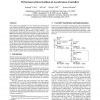Free Online Productivity Tools
i2Speak
i2Symbol
i2OCR
iTex2Img
iWeb2Print
iWeb2Shot
i2Type
iPdf2Split
iPdf2Merge
i2Bopomofo
i2Arabic
i2Style
i2Image
i2PDF
iLatex2Rtf
Sci2ools
ICCAD
1994
IEEE
1994
IEEE
Performance-driven synthesis of asynchronous controllers
We examine the implications of a new hazard-free combinational logic synthesis method [8], which generates multiplexor trees from binary decision diagrams (BDDs) -- representations of logic functions factored recursively with respect to input variables -- on extended burst-mode asynchronous synthesis. First, the use of the BDD-based synthesis reduces the constraints on state minimization and assignment, which reduces the number of additional state variables required in many cases. Second, in cases where conditional signals are sampled, it eliminates the need for state variable changes preceding output changes, which reduces overall input to output latency. Third, selection variables can easily be ordered to minimize the latency on a user-specified path, which is important for optimizing the performance of systems that use asynchronous components. We present extensive evaluations showing that, with only minimal optimization, the BDD-based synthesis gives comparable results in area with...
Related Content
| Added | 08 Aug 2010 |
| Updated | 08 Aug 2010 |
| Type | Conference |
| Year | 1994 |
| Where | ICCAD |
| Authors | Kenneth Y. Yun, Bill Lin, David L. Dill, Srinivas Devadas |
Comments (0)

